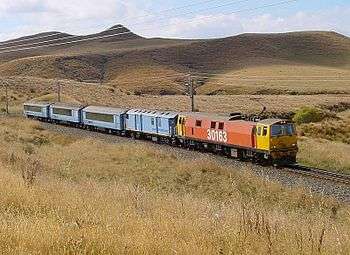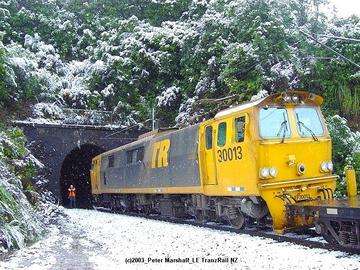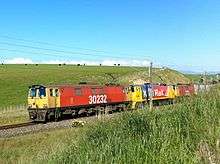New Zealand EF class locomotive
The New Zealand EF class locomotive (originally Class 30) is a class of 22 25 kV 50 Hz AC electric locomotives that operate on the North Island Main Trunk (NIMT) between Palmerston North and Te Rapa (near Hamilton) in New Zealand. They are the only class of electric locomotives in revenue service in New Zealand.
| New Zealand EF class locomotive | |||||||||||||||||||
|---|---|---|---|---|---|---|---|---|---|---|---|---|---|---|---|---|---|---|---|
EF class locomotive 30042 backing onto a Wellington to Auckland passenger train (The Overlander) at Palmerston North, March 2007. | |||||||||||||||||||
| |||||||||||||||||||
| |||||||||||||||||||
| |||||||||||||||||||
| |||||||||||||||||||
The EF class was built by Brush Traction in Loughborough, United Kingdom between 1986 and 1988 to run on the new electrified central section of the NIMT. The locomotives, at 3,000 kilowatts (4,000 hp), are the most powerful locomotives to operate in New Zealand, and the design of the class has been used in designing other electric locomotives overseas, including the Le Shuttle Eurotunnel Class 9 electric locomotives that operate in the Channel Tunnel between the United Kingdom and France.
Background
The NIMT is a 681-kilometre (423 mi) long rail line that links New Zealand's capital Wellington and New Zealand's largest city Auckland, and is one of the major backbones of the country's rail network. The line was completed in 1908 and opened the following year, and included various engineering feats on the central section between Hamilton and Palmerston North, including the Raurimu Spiral and numerous viaducts – five of which are over 70 metres (230 ft) high.
Electrification of the NIMT was first proposed as early as 1918 due to coal shortages during World War I, and later was proposed in the 1950s when diesel locomotives started to replace steam. The section between Wellington and Paekakariki was electrified in 1938 at 1500 V DC to prevent steam build-up in the long Tawa tunnels under the Wellington hills and to provide banking on the steep seaside section from Paekakariki up to Pukerua Bay. This electrification has since been extended further north to Paraparaumu in 1983 and again to Waikanae in 2011.
Following the oil shocks of the 1970s, the National government, led by Prime Minister Robert Muldoon, launched the "Think Big" energy development projects. One of the projects involved the electrification of the 411-kilometre (255 mi) central section of the NIMT between Palmerston North and Te Rapa. This section was chosen for the topography of the line between these two cities, and the advantages electric locomotives had over diesel in this area. The 2,050-kilowatt (2,750 hp) DX class diesel-electric locomotives, then the mainstay of the NIMT and only recently introduced themselves, could handle 720-tonne freight trains on the section, but could only average 27 kilometres per hour (17 mph) when climbing the 1 in 52 gradient of the Raurimu Spiral. A more powerful locomotive however, in this case an electric locomotive, could haul a 900-tonne freight train up the same section of track at a speed of 45 kilometres per hour (28 mph). Electric trains also had advantages during the 1970s oil shocks as New Zealand relied on imported oil to supply its diesel locomotives. Meanwhile, New Zealand's electricity supply is mainly generated from renewable hydroelectricity (hydroelectricity generated 84.5% of New Zealand's electricity in 1980[1]), and therefore electric trains do not have to rely on imported oil to operate.
Service
Introduction
The electrification of the central section began in 1984, with the government setting aside NZ$40 million to purchase a fleet of 25 kV AC locomotives to operate the new electrified line. The contract to build 22 electric locomotives was let to Brush Traction of Loughborough, UK. The first two locomotives, numbered 30007 and 30013, arrived in 1986 and were used in the testing of the new electrification system, while the remaining 20 locomotives were introduced after the electrification of the NIMT was completed.
The locomotives are able to generate a continuous power output of 3,000 kilowatts (4,000 hp), making the class the most powerful to operate on the NZR network. They also feature the unusual wheel arrangement of Bo-Bo-Bo, which had been previously used on the EW class and the DJ class. The advantage of using the Bo-Bo-Bo arrangement over the traditional Co-Co arrangement is that it provides greater flexibility for New Zealand's lightly laid and sharply curved tracks, resulting in less wear on the rails.
The locomotives are supplied electricity from 25 kV AC overhead lines. These lines draw electricity from New Zealand's national grid at four locations along the electrified section: Bunnythorpe, Tangiwai, Taumarunui, and Hamilton. The locomotives are fitted with regenerative braking as well as regular air brakes, so the traction motors can be turned into generators when the locomotive is coasting downhill and feed electricity back into the overhead lines and the national grid.
The EF class were nicknamed "Toasters" by New Zealand rail enthusiasts due to their boxy shape.
In service
The EF class were first used to haul freight trains along the central section of the NIMT. Freight trains travelling from Auckland would be diesel-hauled to Te Rapa, change there to an EF locomotive and be hauled to Palmerston North where they would be changed back to a diesel locomotive to continue to Wellington. This remains the practice today, although trains that do not traverse the length of the central section (such as pulp trains from Karioi mill) are entirely diesel-hauled to save switching the locomotives. Similarly, freight trains that are destined for or originate from the Marton - New Plymouth Line are diesel-hauled for 30 km section of the NIMT between Palmerston North and Marton.
Prior to the Stratford–Okahukura Line being mothballed usual operating practice was for the services originating from Auckland/Hamilton and Stratford to meet at Taumarunui and exchange trains there, with an EF regularly hauling the Hamilton-Taumarunui-Hamilton legs. With the mothballing of this line most services now run direct between Palmerston North and Te Rapa.


Electric-hauled passenger services originated later, due to the then daylight NIMT service, the Silver Fern, utilising diesel-electric rail cars. When the locomotive-hauled Overlander daylight service replaced the Silver Fern in December 1991, EF class locomotives began to be used to haul it across the central section, and later, the locomotives were used on the overnight Northerner passenger service until it was cancelled in November 2004. The EFs were not used initially on the Northern Explorer, however KiwiRail experimented for a short while with towing the whole consist - including the diesel locomotive - over the central section. However the need for locomotives for freight services curtailed this.
Upgrades
With the EF class being relatively young there have been very few upgrades to the locomotives. Only heavy repairs are undertaken at the main Hutt Workshops near Wellington which, due to the non-electrified section between Palmerston North and Waikanae (and Wellington's electrification being DC rather than AC), the locomotives must be towed by a diesel engine to access the workshops. All other work is carried out in Palmerston North.
An upgrade programme was undertaken over 1993 and 1994 which saw the 20 remaining locomotives receive transformer work and overhauled traction motors. This work was undertaken at the Hutt Workshops with EF 30007 the first to be treated after having been out of action for some time prior.
From June 2006, the locomotives have been fitted with AAR style couplers, each weighing over 400 kilograms (880 lb), to allow them to pull heavier trains.
In July 2010, EF 30065 and EF 30128 were assessed for a return to service, having been held in open storage (along with EF 30186) for many years at Palmerston North as surplus to operational requirements. It is hoped that reinstating the locomotives will help to ease pressure on the working fleet, especially as locomotives are currently regularly out of service for maintenance, modification and re-branding. EF 30065 was placed on second-hand bogies and moved to Hutt Workshops in August 2010 to begin the assessment, followed by EF 30186 in September. EF 30128 followed to Wellington in April 2011. It is anticipated that one of the locomotives will serve as a parts source to return the other two to service and the remaining hulk scrapped.
All EFs went through a minor upgrade to ensure reliability before a full overhaul is carried out. The upgrade included replacing the obsolete Locolog event recorder and vigilance system with the latest generation system known as Tranzlog. This system also includes fault recording.
EF 30013 was fitted with a replacement air compressor as a trial during 2012, which all locomotives will now receive. The original compressor has become uneconomic to rebuild and is becoming increasingly difficult to keep functioning. These locomotives can be recognised by a new louver being fitted to 2B side of the locomotive.
Livery

Of the 17 EF Class locomotives currently in service, nine are painted in a livery other than the original International Orange scheme that they were introduced in:
- 10 in the International Orange ("Fruit Salad")
- 1 in Tranz Rail blue ("Cato Blue")
- 3 in Tranz Rail black ("Bumble-Bee")
- 6 in KiwiRail
The remaining three locomotives not in operational service (EFs 30065, 30128 and 30186) are all presently painted in the International Orange scheme. No EFs were ever painted in the Toll Rail "Corn Cob" scheme.
The rust removal and repaint into the new KiwiRail scheme began in September 2009 with 30163, followed by 30059 in February 2010, 30134 in March 2010, 30249 in April 2010, 30226 in July 2010 and 30203 in September 2014. It is expected that the remaining units will be rebranded in KiwiRail livery as they go through extended maintenance. So far, the KiwiRail repainting has been done at Hutt Workshops, which means the locomotives must be towed (as part of a diesel hauled freight service) to and from Wellington. The units painted in International Orange have the road numbers displayed in large type in the centre of the body (with the exception of EF 30007), while the other schemes have them in smaller type on the cabs.
Withdrawal and disposal
Seven EF class locomotives have been withdrawn from service:
EFs 30036 and 30088 were withdrawn from service following a derailment caused by a washout at Oio (north of Raurimu) on 7 August 1991 that also killed the locomotive engineer. After recovery from the site the two heavily damaged units were stored at Hutt Workshops until the decision was made that it was both uneconomic to repair the units and they would be surplus to existing requirements. Both units were scrapped at Hutt Workshops with 30088 being scrapped in April 2003 and 30036 in February 2007. Usable salvaged parts had been stripped to support the remainder of the fleet. 30007 was laid up during the mid-1990s, but was returned to service not long after.
EFs 30065, 30128 and 30186 were laid up in late 1990s/early 2000s and were in long-term storage at Palmerston North as surplus to operational requirements. All three have since been moved to Hutt Workshops. Two other EF locos were withdrawn - 30111 was withdrawn in late 2015 due to requiring an air compressor change, and 30157 was withdrawn after catching fire.[2][3][4] Both locomotives are stored in Palmerston North.
In December 2016, it was announced that the EF class locomotives would be withdrawn over a two-year period and replaced by DL class locomotives, with the overhead lines remaining in place should the need for electric traction arise in the future.[5] EFs 30163 and 30249 were removed from service in the first quarter of 2018.
Overhauls
Following the 2017 general election KiwiRail and the new Labour-led Coalition Government announced on 30 October 2018 that capital funding would made available to refurbish 15 of the 20 EF locomotives at the Hutt Workshops, extending the service life by 10 years for their continued use on the NIMT electrification in line with the new Government's energy and emissions policies.[6][7] EF30226 and EF30163 were transferred to the Hutt Workshops via the Wairarapa line 23 November 2019 for overhaul by KiwiRail in collaboration with original manufacturer Brush, now a subsidiary of Wabtec Corporation.[8]
Outside New Zealand
The EF class design was used as the basis for the Le Shuttle Eurotunnel Class 9 locomotives used in the Channel Tunnel by the Eurotunnel Shuttle Service, as a proven design was required. The Le Shuttle locomotives were also built by Brush, Loughborough, UK and were scaled up to the standard rail gauge and larger loading gauge used in Europe.[9]
See also
References
- "Energy Data File". Ministry of Economic Development. 2 July 2009. Archived from the original on 5 December 2009. Retrieved 4 July 2009.
- "Electric locomotive fire at Palmerston North Terminal, 25 November 2015" (PDF). TAIC. 13 April 2017.
- "Train fire at Palmerston North rail yard". Manawatu Standard. 25 November 2015. Retrieved 25 November 2015.
- "Statuses for EF's 30111 and 30157 (Official Information Act request)". fyi.org.nz. KiwiRail. 13 February 2017. Retrieved 28 March 2017.
- "KiwiRail announces fleet decision on North Island line". KiwiRail. 21 December 2016. Retrieved 22 December 2016.
- "KiwiRail Press Statement - Electric locomotives to continue with Government investment". KiwiRail. 30 October 2018. Retrieved 2 March 2019.
- "Government Saves Electric Trains". Scoop Parliament. 30 October 2018. Retrieved 6 November 2018.
- "Railfan". Volume 26 No.1. Triple M Publishing. Summer 2020. ISSN 1173-2229. Cite journal requires
|journal=(help) - Semmens & Machefest-Tassin 1994.
Bibliography
- Parsons, David (2002). New Zealand Railway Motive Power 2002. New Zealand Railway and Locomotive Society. p. 64. ISBN 978-0-908573-78-3.
- Heath, Eric; Stott, Bob (1993). Classic Railcars, Electric and Diesel Locomotives Of New Zealand. Grantham House. ISBN 1869340418.
- Semmens, P.W.B.; Machefest-Tassin, Y. (1994). Channel Tunnel Trains. Folkestone, Kent: Channel Tunnel Group Ltd. ISBN 1872009336.
| Wikimedia Commons has media related to NZR EF class. |